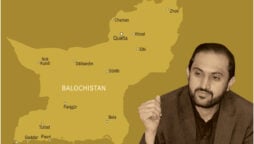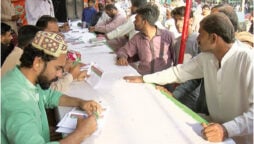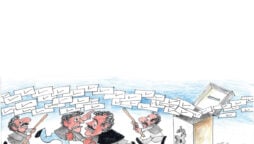The country’s economic indicators today are darker than the rain clouds that wreaked devastation across the land
We, especially the media, are so obsessed with national politics, point-scoring rhetoric and the ongoing power struggle, that little space is left for public discourse on the real, substantial issues facing the country. This is the inescapable, hard reality, even though these issues hold existentialist significance for us. A small group of intelligentsia debates these issues, but the common people and policymakers seem oblivious to them. And as a result, are visible signs of decay and collapse in the form of unprecedented inflation and extensive devastation, caused by heavy rains and consequent floods.
Our economy is in shambles, and it is largely so because we have not focused as much on meaningful productivity as we have on ostentatious projects such as motorways and flashy airport terminals built with expensive foreign loans. In the last fiscal year, for instance, the country exported goods worth $31.8 billion as against imports worth $80 billion. The trade deficit stood at $48.2 billion. Unless we radically boost our industrial production, the foreign exchange crisis will continue. Pakistan will remain on the brink, surviving on international loans. Fast-paced industrialisation should be at the top of our economic agenda if we want to have a viable, sustainable economy. Our 1000-km long coastal belt is low-hanging fruit if we focus on developing industrial hubs here like China did in its western coastal region.
Another key issue is the fact that we are living way beyond our means. For the most part, the affluent sections of our society do not pay their due taxes. This fiscal year (2022-23), more than 41 per cent of the federal government’s total tax collection will go towards debt repayment. After the payment of interest on debts, defence, grants and subsidies, the federal government is left with 10 per cent of the total revenues. So, it seeks fresh loans (foreign and domestic) to meet the outlays on current and development expenditures. Under the constitution, as it stands today, the federal government cannot levy income tax on rich farmers, even though their individual earnings run into tens of millions of rupees. All the landlords of the country combined do not contribute, through nominal provincial taxes, more than even half per cent of the total revenues collected by the federal and four provincial governments. It is estimated that nearly four million medium and small traders are also outside the tax net. The collection of tax from a large prosperous segment of the society is a major political issue that needs to be addressed post-haste. But no government dares to stir the hornets’ nest. Unless there is a strong political will and decisive measures are taken to increase tax collection, the government’s finances will remain dependent on loans. This indirectly affects the growth of the private sector and leads to inflation and depreciation of the rupee.
The economy cannot be fully fixed without investing heavily in the education sector. Illiterate workers cannot run a modern economy. We have an abysmally low literacy rate (62.3 per cent in 2021) — the lowest in South Asia. In Pakistan, more than 60 million people are illiterate as per official statistics. Currently, the nation is spending 2.5 per cent of GDP on education, which is far less than 4 per cent as generally recommended by international experts.
The situation is compounded by the fact that the population bomb is ticking for Pakistan, with an annual growth rate of around two per cent. Currently, we have a population of 230 million. The UN’s report “World population Prospects 2022” projects there will be 366 million people in Pakistan by the year 2050. There is little realisation among the common people, especially in rural areas, about the economic and social impact of having a large family. Family planning has traditionally been low on the government’s agenda. If the population keeps growing at this rate, it constitutes a big risk for the economy and internal security of the country. Providing employment to the youth bulge is a huge and growing challenge. According to the Pakistan Labour Force Survey 2020-21, around 1.61 million people are annually added to the country’s employed Labour force.
A nearly seven-fold surge in population since Independence has resulted in the scarcity of water availability. In 1947, Pakistan’s average annual per capita water availability was 5,600 cubic metres. Now it has plummeted to 1,038 cubic metres, making us severely water-stressed. Some experts argue that we have even less water than the official figures state. Currently, two-thirds of the people living in 24 major cities of Pakistan do not have access to clean water. If the water crisis is not solved, the impact could be dire. The scarcity of water may lead to riots in the city and food shortages for the bulging population. This is also linked to food security. Despite being an agricultural country, Pakistan is forced to import wheat, cotton, sugar, cooking oil, and pulses from abroad. The country needs to bring under cultivation more barren lands by digging new canals. In our country, almost 95 per cent of available water is used for agriculture, which has a very inefficient, archaic system of irrigation that floods fields of crops, wasting 60 per cent of the water. Food security can be achieved by improving the country’s water management and irrigation methods. In addition to more water reservoirs, the state needs to modernise the irrigation system by investing in the lining of canals, and adopting modern methods such as sprinkle-irrigation and drip-irrigation techniques. The sooner we embark on this journey, the better for our peace and food security.
No less important is energy security. Pakistan is fast running out of gas reserves. Currently, local natural gas provides for only 45 per cent of our requirement, with 55 per cent coming from abroad in the form of Liquefied Natural Gas. Nearly 2.8 million households have been waiting for years for new gas connections. Pipeline gas from Iran, available at nearly half the rate of LNG, could be a game-changer. It can give our economy a big boost and meet all our requirements. This one move can substantially reduce our energy bill. If we can buy onions and tomatoes from Iran, why can’t we buy energy which is so crucial for our survival?
The recent flooding once again proves that Pakistan is among the most vulnerable countries in relation to climate impact, but it is also the least prepared to face the challenge. The country faces six types of floods, including riverine floods in summers such as the one in 2010, flash floods (the ones in South Punjab, Balochistan), glacial-lake outburst floods (northern areas), urban floods (Karachi, Lahore etc), torrential rains (Sindh this year) and cloud outbursts (Islamabad in July last year). The southern districts of Sindh face vulnerability of seawater intrusion, while the northern areas are prone to snowstorms, such as the one in Murree in January this year. Pakistan needs a comprehensive policy and action plan, not mere rhetoric by high-ups, to protect our population from the vagaries of climate change. The Pakistani state and civil society need to take solid measures for adaptation to the changing climate conditions.
Some more issues that need urgent redressal can be added to the list highlighted above, such as bad governance, an inefficient and ineffective dispute-resolution system, poor decentralisation and devolution of power, widespread corruption, etc. However, the key to the resolution of all these issues lies in the mass awakening of people and their active participation in politics, so that the governing class is compelled to draw out remedial and far-reaching measures and make and implement these policy decisions.
Catch all the National Nerve News, Breaking News Event and Latest News Updates on The BOL News
Download The BOL News App to get the Daily News Update & Live News.











 Read the complete story text.
Read the complete story text. Listen to audio of the story.
Listen to audio of the story.